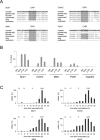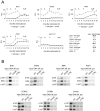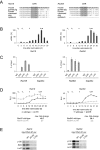The CHR site: definition and genome-wide identification of a cell cycle transcriptional element
- PMID: 25106871
- PMCID: PMC4176359
- DOI: 10.1093/nar/gku696
The CHR site: definition and genome-wide identification of a cell cycle transcriptional element
Abstract
The cell cycle genes homology region (CHR) has been identified as a DNA element with an important role in transcriptional regulation of late cell cycle genes. It has been shown that such genes are controlled by DREAM, MMB and FOXM1-MuvB and that these protein complexes can contact DNA via CHR sites. However, it has not been elucidated which sequence variations of the canonical CHR are functional and how frequent CHR-based regulation is utilized in mammalian genomes. Here, we define the spectrum of functional CHR elements. As the basis for a computational meta-analysis, we identify new CHR sequences and compile phylogenetic motif conservation as well as genome-wide protein-DNA binding and gene expression data. We identify CHR elements in most late cell cycle genes binding DREAM, MMB, or FOXM1-MuvB. In contrast, Myb- and forkhead-binding sites are underrepresented in both early and late cell cycle genes. Our findings support a general mechanism: sequential binding of DREAM, MMB and FOXM1-MuvB complexes to late cell cycle genes requires CHR elements. Taken together, we define the group of CHR-regulated genes in mammalian genomes and provide evidence that the CHR is the central promoter element in transcriptional regulation of late cell cycle genes by DREAM, MMB and FOXM1-MuvB.
© The Author(s) 2014. Published by Oxford University Press on behalf of Nucleic Acids Research.
Figures









Similar articles
-
The CHR promoter element controls cell cycle-dependent gene transcription and binds the DREAM and MMB complexes.Nucleic Acids Res. 2012 Feb;40(4):1561-78. doi: 10.1093/nar/gkr793. Epub 2011 Nov 7. Nucleic Acids Res. 2012. PMID: 22064854 Free PMC article.
-
Polo-like kinase 4 transcription is activated via CRE and NRF1 elements, repressed by DREAM through CDE/CHR sites and deregulated by HPV E7 protein.Nucleic Acids Res. 2014 Jan;42(1):163-80. doi: 10.1093/nar/gkt849. Epub 2013 Sep 25. Nucleic Acids Res. 2014. PMID: 24071582 Free PMC article.
-
The forkhead transcription factor FOXM1 controls cell cycle-dependent gene expression through an atypical chromatin binding mechanism.Mol Cell Biol. 2013 Jan;33(2):227-36. doi: 10.1128/MCB.00881-12. Epub 2012 Oct 29. Mol Cell Biol. 2013. PMID: 23109430 Free PMC article.
-
Cell cycle arrest through indirect transcriptional repression by p53: I have a DREAM.Cell Death Differ. 2018 Jan;25(1):114-132. doi: 10.1038/cdd.2017.172. Epub 2017 Nov 10. Cell Death Differ. 2018. PMID: 29125603 Free PMC article. Review.
-
The central role of CDE/CHR promoter elements in the regulation of cell cycle-dependent gene transcription.FEBS J. 2010 Feb;277(4):877-93. doi: 10.1111/j.1742-4658.2009.07508.x. Epub 2009 Dec 15. FEBS J. 2010. PMID: 20015071 Review.
Cited by
-
Emerging Role of the DREAM Complex in Cancer and Therapeutic Opportunities.Int J Mol Sci. 2025 Jan 1;26(1):322. doi: 10.3390/ijms26010322. Int J Mol Sci. 2025. PMID: 39796178 Free PMC article. Review.
-
Targeted analysis of dyslexia-associated regions on chromosomes 6, 12 and 15 in large multigenerational cohorts.PLoS One. 2025 May 27;20(5):e0324006. doi: 10.1371/journal.pone.0324006. eCollection 2025. PLoS One. 2025. PMID: 40424442 Free PMC article.
-
Aberrantly activated Gli2-KIF20A axis is crucial for growth of hepatocellular carcinoma and predicts poor prognosis.Oncotarget. 2016 May 3;7(18):26206-19. doi: 10.18632/oncotarget.8441. Oncotarget. 2016. PMID: 27036048 Free PMC article.
-
Chlamydomonas CHT7 Is Required for an Effective Quiescent State by Regulating Nutrient-Responsive Cell Cycle Gene Expression.Plant Cell. 2020 Apr;32(4):1240-1269. doi: 10.1105/tpc.19.00628. Epub 2020 Jan 30. Plant Cell. 2020. PMID: 32001503 Free PMC article.
-
HDAC activity is dispensable for repression of cell-cycle genes by DREAM and E2F:RB complexes.Nat Commun. 2024 May 24;15(1):4450. doi: 10.1038/s41467-024-48724-0. Nat Commun. 2024. PMID: 38789411 Free PMC article.
References
-
- Müller G.A., Engeland K. The central role of CDE/CHR promoter elements in the regulation of cell cycle-dependent gene transcription. FEBS J. 2010;277:877–893. - PubMed
-
- Schmit F., Cremer S., Gaubatz S. LIN54 is an essential core subunit of the DREAM/LINC complex that binds to the cdc2 promoter in a sequence-specific manner. FEBS J. 2009;276:5703–5716. - PubMed
-
- Litovchick L., Sadasivam S., Florens L., Zhu X., Swanson S.K., Velmurugan S., Chen R., Washburn M.P., Liu X.S., DeCaprio J.A. Evolutionarily conserved multisubunit RBL2/p130 and E2F4 protein complex represses human cell cycle-dependent genes in quiescence. Mol. Cell. 2007;26:539–551. - PubMed
-
- Schmit F., Korenjak M., Mannefeld M., Schmitt K., Franke C., von E.B., Gagrica S., Hanel F., Brehm A., Gaubatz S. LINC, a human complex that is related to pRB-containing complexes in invertebrates regulates the expression of G2/M genes. Cell Cycle. 2007;6:1903–1913. - PubMed
Publication types
MeSH terms
Substances
LinkOut - more resources
Full Text Sources
Other Literature Sources
Research Materials
Miscellaneous

